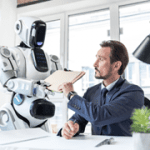The modern workplace has several “employees” who are relatively new to the organization: big data, machine learning, and predictive analytics, to name a few.
 Traditional workforces were mainly human-powered. And human resources are still crucial, to be sure, but business automation is changing many processes and strategies.
Traditional workforces were mainly human-powered. And human resources are still crucial, to be sure, but business automation is changing many processes and strategies.
For instance, in the traditional workplace, there likely would have been one (or more) staff roles dedicated to data entry. With the introduction of big data technology, however, much of that process can be automated, making the human data entry role mostly redundant in some industries.
The same can be true for other parts of the business — chatbots for the customer service department, predictive analytics for the financial forecasting team, machine automation for the warehouse department, etc.
To the last one, certain industries have even found that machines can do more than human employees can. For instance, the Ocado Smart Platform is revolutionizing the retail industry – particularly grocery – by having machine robotics that can stock warehouse shelves, fill delivery orders, and keep food fresh up to the last minute by packing it in sub-zero temperatures.
Machine learning is also on the horizon, with certain robots developing creative intelligence — for example, IBM’s Watson made a movie trailer. This will probably take a few decades to advance to actual creative job replacement, but it could happen.
With all these technological advances, it can be easy to paint a doom-and-gloom picture for human employees. Some experts have even predicted that by 2030 up to 800 million jobs will be eliminated by the use of robots. But, in our opinion, the workforce of the future won’t be robot-only — it will still require people — but the required roles will shift.
Look at history for an example. The industrial revolution didn’t stifle human jobs; it just created different ones.
There are certain roles that (as of today) are still more suited to humans, such as:
- Unpredictable physical work, such as construction, forestry, raising animals, etc.
- Analyzing and interpreting data.
- Social interaction roles, such as sales, escalating customer service, personalized offers, social media management, etc.
- Future-focused activities, such as product development, brainstorming, strategizing, etc.
- Programming and supervising robots, etc.
- Customer experience, user experience (UX), creative thinking, etc.
- Roles requiring emotional intelligence, such as healthcare.
Business technology, especially robotics, is also still a big investment, so it doesn’t necessarily cost less than a human staff member. There is the upfront cost, implementation, and then maintenance to consider. Plus, since the technology is still new and emerging in some cases, you may actually double up on some roles, with a human plus a “machine.”
Instead of seeing business automation as replacing the human workforce, many experts are instead looking at human-robot collaboration. The New York Times reported that robots make warehouse work less tedious for people, and also create efficiency gains for both the business and the customer. This can enable human employees to take on more enjoyable roles.
By taking advantage of business automation technology, such as big data tools, machine learning, and predictive analytics, companies can become more efficient, more insightful, and more profitable.
SHEA Global can help your business develop an automation plan. We can assess current opportunities for your organization, plus take a realistic look at what future roles may look like.
Contact us today to transform your modern workforce. Call (905) 470 6830 or visit SHEAGlobal.com.